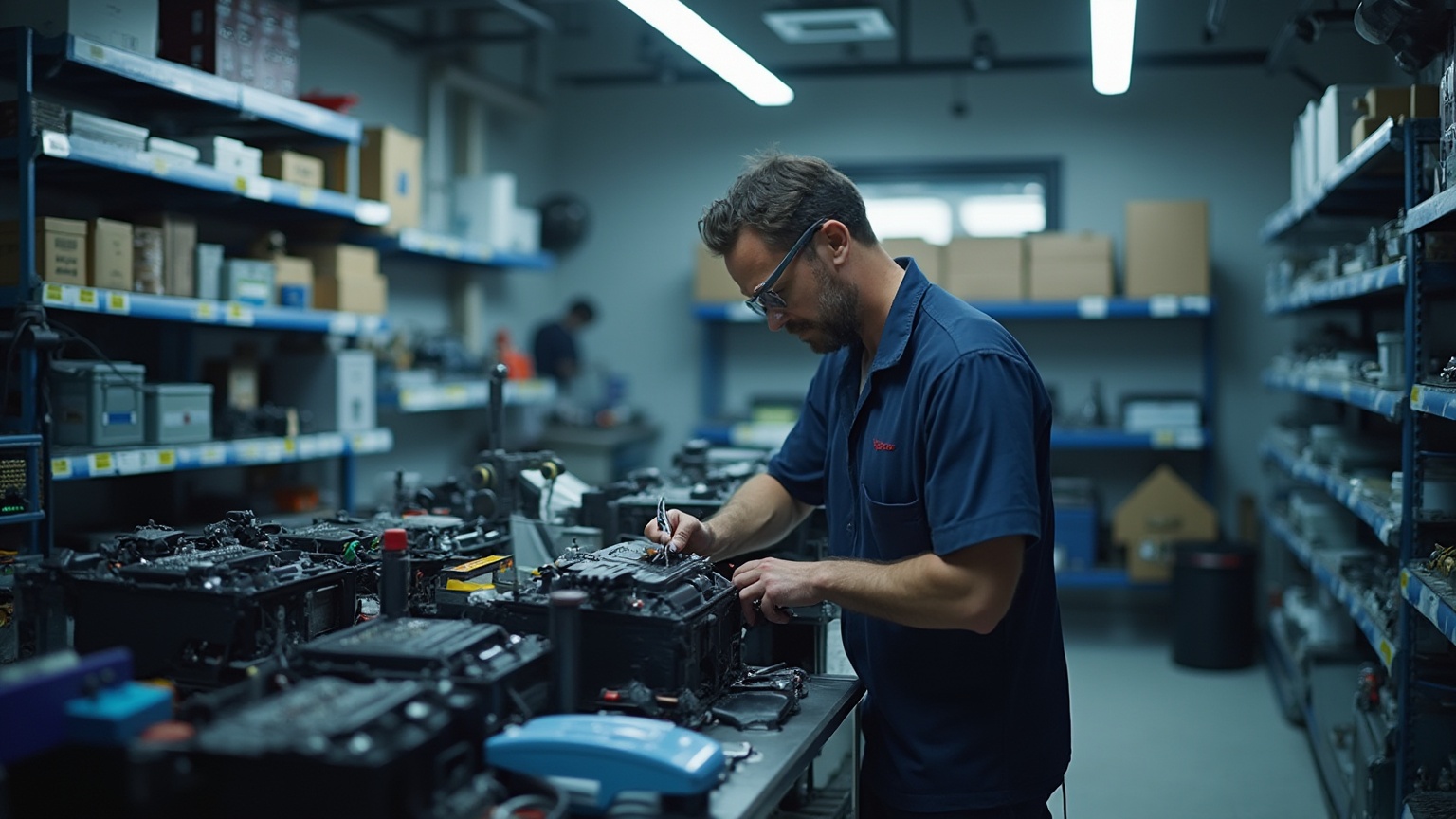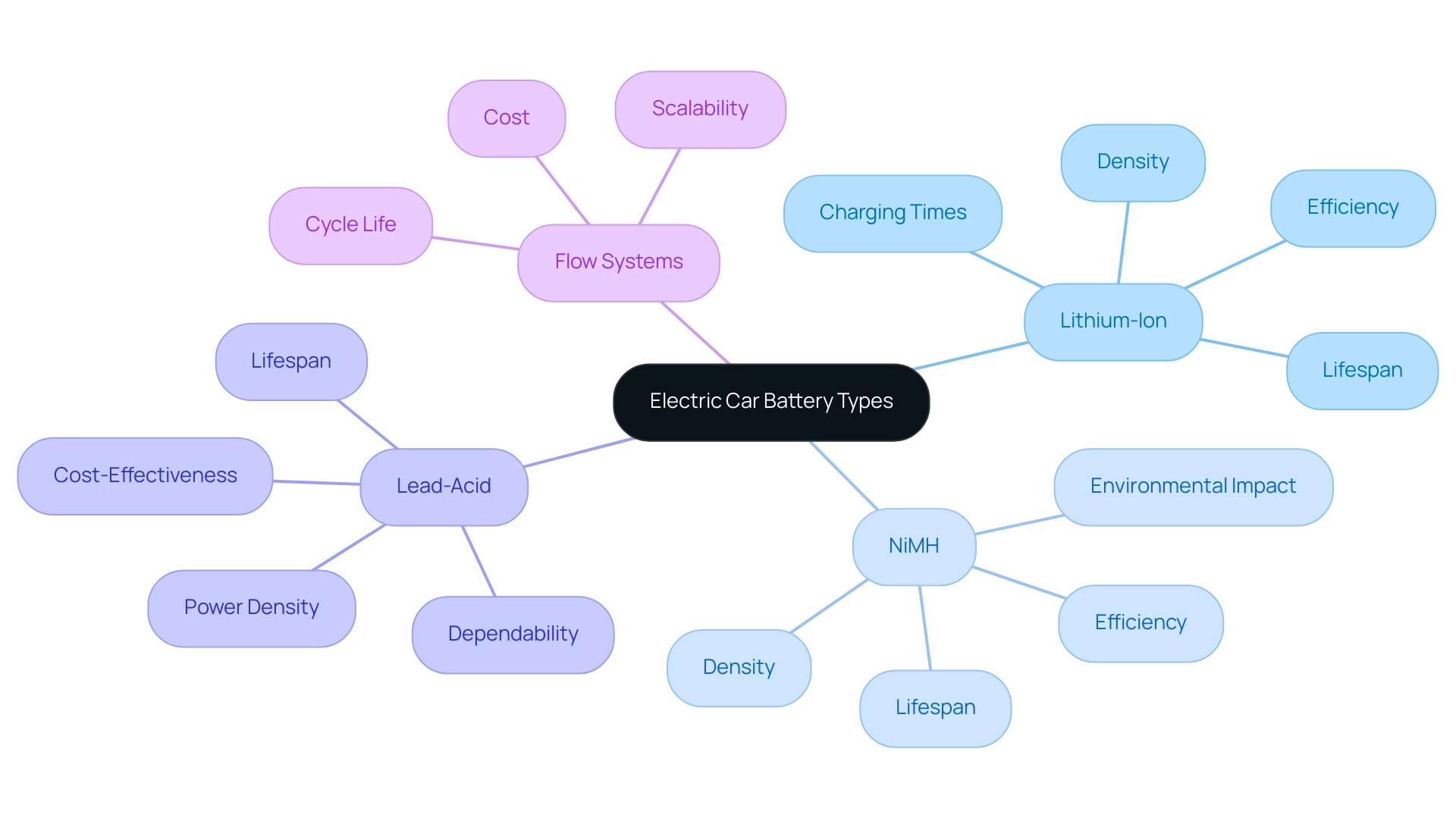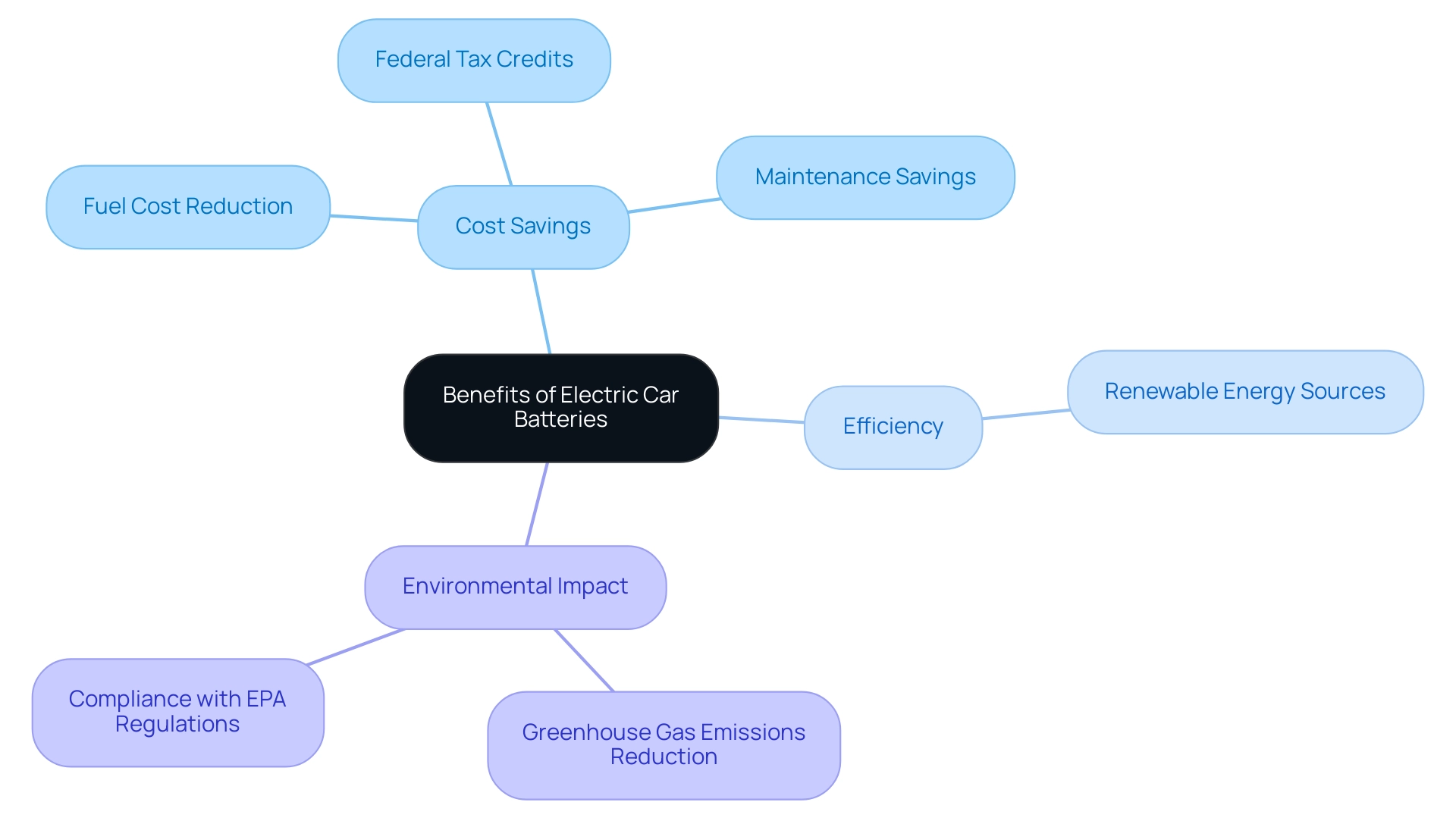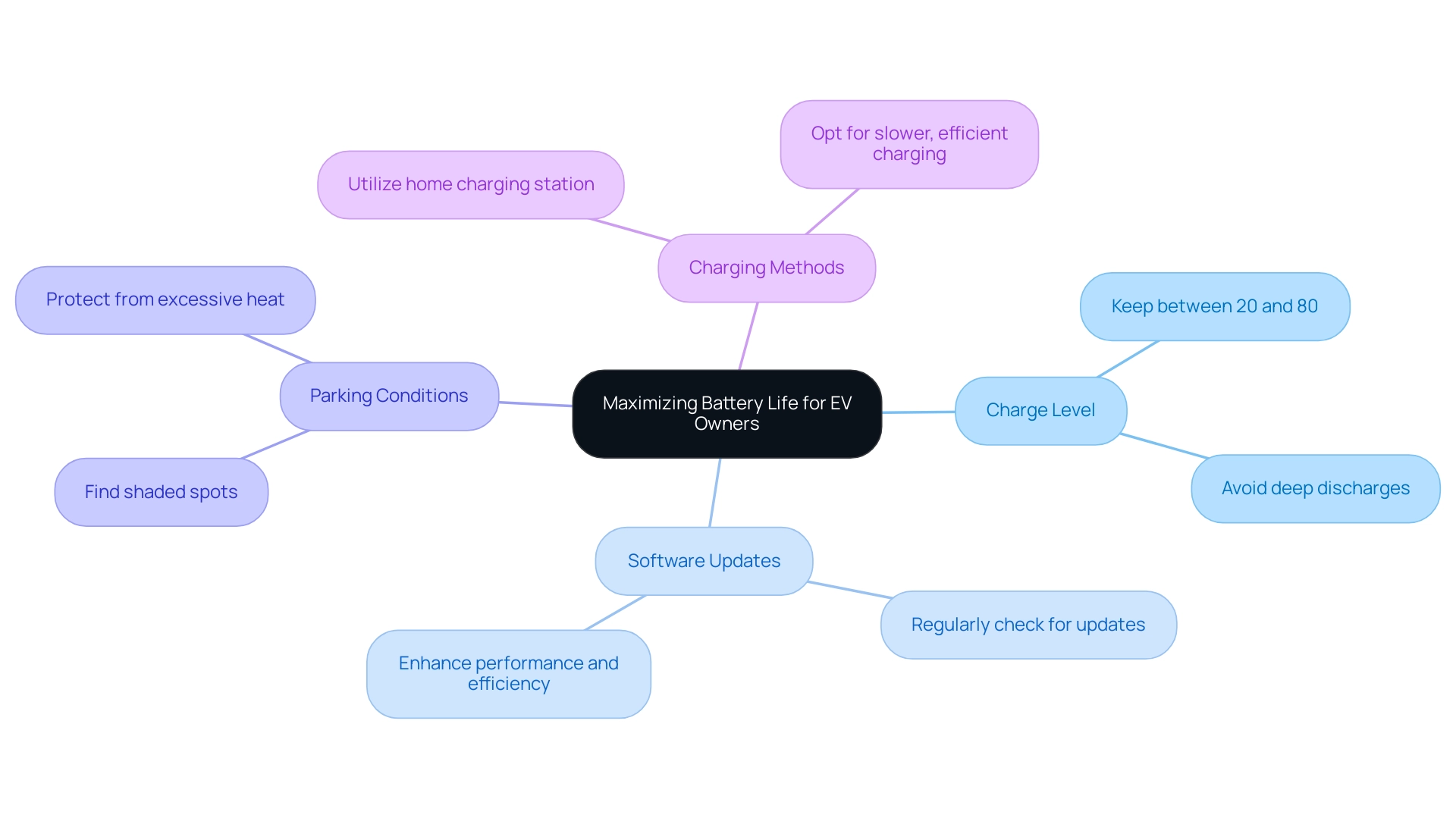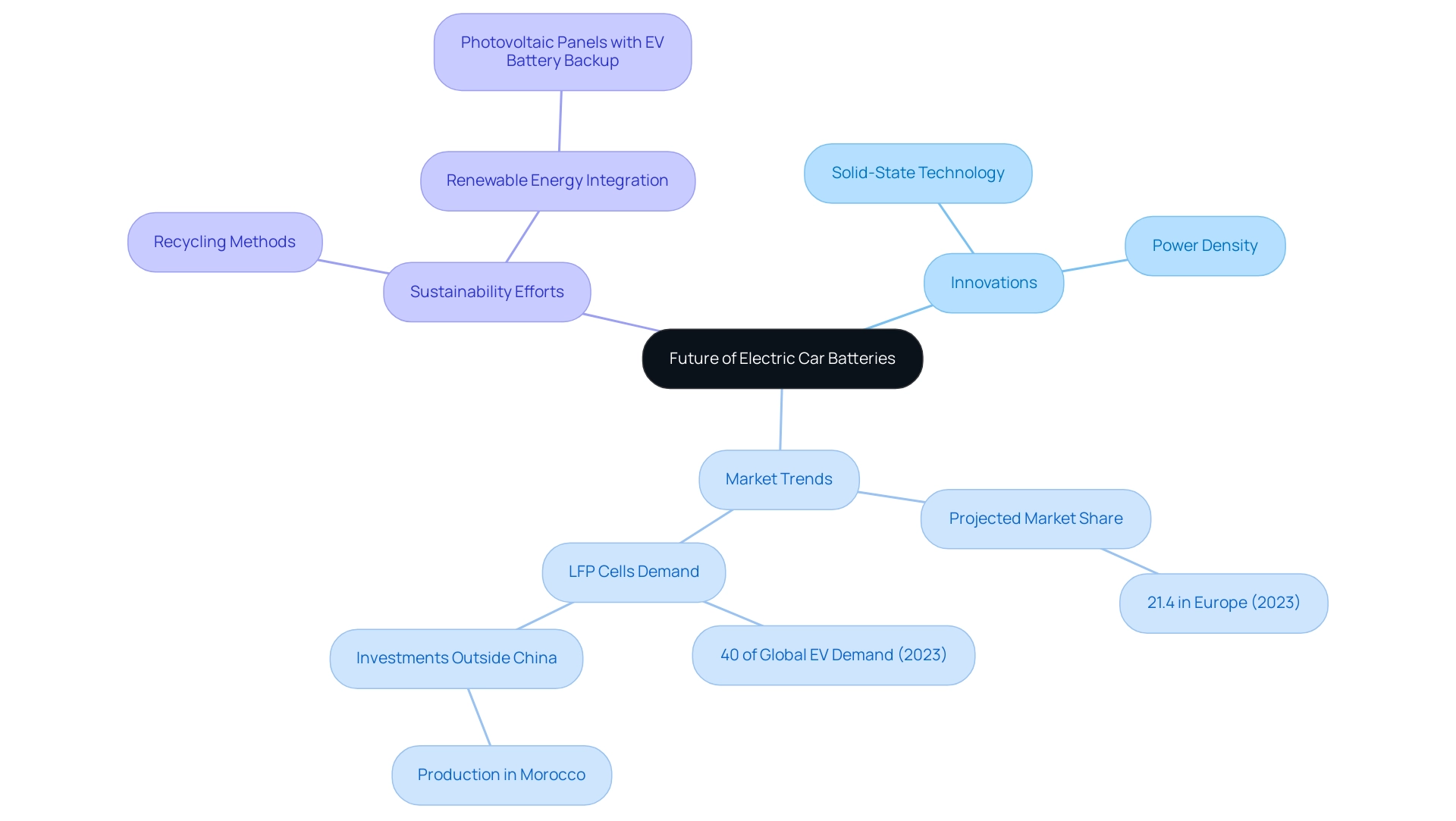Overview
Electric car battery backup offers significant benefits, including cost savings on fuel and maintenance, along with a reduced environmental impact when powered by renewable energy sources. The article highlights that by integrating electric vehicle power storage with solar panels, homeowners can enhance energy efficiency, decrease reliance on the grid, and contribute to sustainable living, thus making a compelling case for the adoption of electric car battery systems.
Introduction
As the world shifts towards more sustainable energy solutions, electric car batteries are emerging as key players in this transformation. Homeowners are increasingly recognizing the dual benefits of these batteries, not only powering their electric vehicles but also serving as reliable energy storage systems for their homes.
With advancements in battery technology, particularly lithium-ion and solid-state options, the potential for maximizing energy efficiency is greater than ever. This article delves into the various types of electric car batteries, their advantages, maintenance tips to extend their lifespan, and innovative ways to incorporate them into home energy systems.
By understanding these aspects, homeowners can make informed decisions that align with their eco-friendly values while reaping financial benefits.
Understanding Electric Car Battery Types and Their Functions
When discussing storage options for electric transportation and photovoltaic systems, electric car battery backup utilizing lithium-ion cells is the most favored selection because of their remarkable density and efficiency. They not only store more power but also have a longer lifespan compared to alternatives like nickel-metal hydride (NiMH) batteries, which tend to be heavier and less efficient. This understanding is crucial for eco-conscious homeowners aiming to maximize their potential from both electric vehicles (EVs) and solar power systems.
As of 2024, lithium-ion technology continues to evolve, improving charging times and overall performance, making it an attractive option for those seeking sustainable energy solutions. While NiMH cells have their merits, particularly in their environmentally friendly materials, they often fall short in performance compared to lithium-ion types.
In addition to lithium-ion and NiMH energy storage options, homeowners should consider lead-acid and flow systems. Lead-acid cells are recognized for their cost-effectiveness and dependability, making them a popular option for off-grid solar systems, although they have a shorter lifespan and reduced power density. Flow systems, conversely, provide scalability and extended cycle life, rendering them appropriate for larger storage requirements, but they often come at a higher cost.
The increase in electric transport registrations, particularly in areas such as Southeast Asia where nations like Thailand are developing as EV manufacturing centers, emphasizes the expanding acceptance of these technologies and their effects on storage systems. As the market for electric transports expands, the demand for effective solar storage solutions that can sustainably power homes with electric car battery backup also increases. Comprehending these power source alternatives not only assists in making educated decisions about automobiles and energy systems but also promotes the larger objective of sustainable living.
The Benefits of Electric Car Batteries: Cost, Efficiency, and Environmental Impact
Electric car battery backup presents a multitude of advantages that are particularly appealing to eco-conscious homeowners. One of the major benefits is the significant reduction in fuel costs; electricity is considerably cheaper than gasoline, allowing drivers to save substantially at the pump. The initial costs of electric automobiles (EVs) can often be mitigated by these fuel savings, as well as by accessing federal tax credits and local incentives.
For instance, Duke Energy provides a one-time credit of over $1,100 per charger in select regions, making the shift to electric transportation even more financially appealing.
Additionally, electric modes of transport usually involve reduced maintenance expenses because of their simpler engines with fewer moving components, leading to fewer repairs and more enduring performance. The environmental influence of electric cars is another compelling reason to consider them. By operating electric cars, homeowners can greatly diminish their greenhouse gas emissions, particularly when their automobiles are fueled by renewable resources such as sunlight.
As the EPA suggests new emissions regulations aimed at decreasing CO emissions by 2055, the argument for shifting to electric vehicles becomes more compelling.
Moreover, insights from recent articles highlight the rising trend of incorporating renewable power solutions, such as electric car battery backup systems, Tesla home chargers, and efficient panel systems, into eco-conscious lifestyles. Government programs, such as the federal tax credit for renewable energy, can further incentivize homeowners to invest in photovoltaic panels, making the initial investment more manageable. Moreover, services that focus on panel cleaning ensure that these systems function at optimal efficiency, maximizing power generation.
A recent case study titled ‘Cost Considerations for Electric Vehicles’ illustrates that while purchase prices for EVs may be higher, these costs are likely to balance out as production ramps up and technology advances, ultimately making EVs more financially viable. Embracing electric transport is not merely a wise financial choice; it’s also a commitment to responsible environmental stewardship. As Sam Becker, a contributor focused on finance and strategy, points out, the appeal of electric vehicles continues to rise for those who seek to be both budget-conscious and environmentally friendly, especially when paired with comprehensive solar energy solutions offered by companies like Powercore Electric Inc.
Maximizing Battery Life: Maintenance Tips for Electric Vehicle Owners
To get the most out of your electric car battery backup and extend its life, aim to keep your charge level between 20% and 80%. This recommendation aligns with research indicating that realistic consumer EV driving falls within the identified discharge rate sweet spot. Avoiding deep discharges is crucial for maintaining the health of the electric car battery backup.
It’s also a good idea to regularly check for software updates, as these can enhance performance and ensure you’re getting the best efficiency from your vehicle. When parking, try to find shaded spots to protect your power source from excessive heat. Additionally, if you have a home charging station, utilizing it for slower, more efficient charging can work wonders for the longevity of your electric car battery backup.
As Simona Onori, Associate Professor of Energy Science and Engineering, notes, ‘This work highlights the power of integrating multiple areas of expertise – from materials science, control, and modeling to machine learning – to advance innovation.’ By following these simple yet effective tips, you can enhance your power source’s lifespan and overall performance, making your ride as eco-friendly as possible. Furthermore, insights from the case study ‘Implications for Future Energy Storage Research’ emphasize the importance of evaluating new chemistries and designs, which can provide a broader context for these maintenance tips.
The Future of Electric Car Batteries: Innovations and Sustainability
The future of electric vehicle power sources is incredibly promising, characterized by exciting innovations, particularly in solid-state technology. These advanced batteries are designed to provide greater power density and quicker charging durations, making electric modes of transport even more practical and attractive. As Hussain from QuantumScape aptly notes, ‘We believe that the demand will follow once automakers and consumers see the advantages—greater density, faster charging, and enhanced safety.’
This optimism is supported by recent trends; for example, the electric transport market share in Europe is projected to reach an impressive 21.4% in 2023, reflecting a growing acceptance of electric mobility among eco-conscious homeowners. To successfully combine electric vehicles with renewable power systems, homeowners can contemplate installing photovoltaic panels alongside an electric car battery backup. This setup not only charges the electric transport but also serves as an electric car battery backup for energy storage, enabling the use of solar energy even during non-sunny hours.
Moreover, companies are now prioritizing recycling methods for energy storage systems to minimize waste, enhancing the sustainability of electric vehicles while contributing to decreased overall costs through improved resource efficiency. The ‘Global EV Outlook 2024’ report from the IEA highlights these trends, underscoring the rapid advancements in energy storage technologies. With lithium iron phosphate (LFP) cells capturing over 40% of global EV demand by capacity in 2023, primarily driven by production in China, the expiration of core LFP patents has sparked significant investments in production outside China, including in places like Morocco.
As we approach 2024, innovations like solid-state energy storage are anticipated to further transform the market, enabling homeowners to make eco-friendly choices that reflect their values and aid in creating a more sustainable future.
Powering Your Home with Electric Car Batteries: A New Energy Solution
Electric vehicle power storage units, particularly when combined with a photovoltaic system, act as an excellent supplementary power supply for residences, exemplifying the advantages of electric car battery backup. Imagine this: on sunny days, your solar panels produce surplus power. By utilizing your electric car battery backup for home power storage, you can capture that surplus for later use—whether at night or during unexpected power outages.
This innovative method not only enhances your power security with electric car battery backup but also decreases your reliance on the grid, ultimately resulting in substantial cost savings. Studies indicate that the average household values solar power over conventional grid power by as much as 29 cents per kilowatt-hour. Moreover, electric vehicle power sources can provide electricity back to the grid during peak demand periods, enhancing a more robust power landscape.
By adopting this forward-thinking solution, you’re enhancing your home’s efficiency and stepping confidently into the future of sustainable living. As Christian Kaps, an assistant professor at Harvard School of Business, aptly puts it, ‘It may be prudent for regulators to reevaluate what the relation between private consumers and the electricity grid should be.’ This ongoing dialogue is crucial as we witness the growth of battery adoption, highlighting the need for collaboration among companies, governments, researchers, and climate advocates to support the transition to cleaner power solutions.
To further protect your home and maximize savings, consider integrating photovoltaic panels and exploring roofing improvements. Additionally, recent insights, such as the pricing of Tesla home chargers and available government solar panel programs, can provide valuable information for homeowners looking to enhance their energy independence.
Conclusion
Electric car batteries are not just a trend; they represent a significant shift towards sustainable energy solutions that can benefit both homeowners and the environment. By understanding the various types of batteries available—primarily lithium-ion, but also including options like NiMH, lead-acid, and flow batteries—homeowners can make informed choices that enhance their energy efficiency. The advantages of electric car batteries extend beyond just powering vehicles; they serve as reliable energy storage systems that can store excess solar energy, ultimately reducing dependence on the grid and lowering energy costs.
Maintaining these batteries properly is crucial for maximizing their lifespan and efficiency. Simple practices, such as keeping charge levels within the optimal range and avoiding extreme temperatures, can greatly enhance performance. The future of electric car batteries is bright, with innovations like solid-state technology on the horizon, promising even greater efficiency and sustainability.
As the market for electric vehicles continues to grow, integrating these batteries into home energy systems becomes increasingly practical. This not only contributes to personal financial savings but also aligns with a broader commitment to environmental stewardship. By embracing electric car batteries and the potential they hold, homeowners can play an active role in the transition to a more sustainable and resilient energy landscape. The journey towards energy independence and ecological responsibility starts with informed choices, and now is the time to take that step forward.


